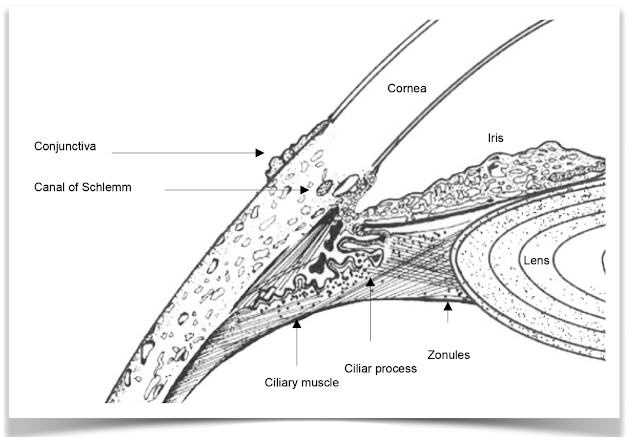Meet Your Eye Musckes
You may not realise it but your eye muscles are what make it possible for you to read this article. Most of the talk about vision evolves around the optical parts, especially the lens. However, the lens is only responsible for about 10% of your ability to focus, the cornea being responsible for the balance of 80%. Also, without the amazing interplay that takes place among the 12 muscles located around your eyes, you would not be able to experience the world as you do. Without the eye muscles you would only be able to see what’s directly in front of you. Eye movement problems are often the root cause of learning problems so let’s look at the work your eye muscles do.
Muscles inside your eye
The most well-known eye-muscle is the cilliar muscle which is a ring muscle located around the lens. When the cilliary muscle contracts the stress across the lens is relaxed and the lens will expand, and your eyes will be able to accommodate or focus on the near. On the other hand, when the cilliar muscle relaxes, the little fibres around the lens are stretched and the lens become flatter, and you are able to focus on distant objects.
This is based on a theory first proposed by German scientist H. Helmholtz in 1866. Modern research by Sachcha (1993) and others used modern testing equipment capable of accurately measuring the dimensions of the lens when looking near and far. The studies showed an expansion of between 100 and 200 microns (50 microns is the width of a human hair). This is not enough to account for the eyes’ ability to instantly alter focus by - 3.00 diopters when shifting from looking outside to reading a book.
In the iris, the coloured part of your eye, there are two muscles that contract or expand, depending on the ambient light, to achieve optimum focus. This is similar to a camera. In the dark, the iris opens up wide to let in more light but in the sunlight it closes to prevent the bright light from hurting the eye.
Muscles around your eye
Around the front of the eyeball there are four muscles. These muscles move the eye sideways as well as up and down. At the back of the eye there are two oblique muscles which are involved in turning the eyes in and out, which enable eye-coordination. Medical experiments done by William Bates M.D. (1919) show that the eye cannot accommodate or focus properly if the nerve that controls the oblique muscles is numb. Bates’s theory is that the oblique muscles are involved in controlling the size of the eye ball to keep the optic parts of the eye focused sharply on the retina.
Vision is dynamic, in the sense that you move your eyes around and focus on various points in space. In doing so, pressure is exerted on the eyeball as it moves. In other words, the exterior eye muscles work together to compensate for changes in the shape of the eyeball in order to keep the image sharply focused on your retina. Bates compares the eye to a bellows camera where the lens is moved back and forth until the image is sharply focused on the film.
Research by Peter Green, Harvard University, (1978) shows that tension held in the oblique muscles contributes to elongation of the eyeball, which is typical of myopia.
When reading, most of the work is performed effortlessly by the eye muscles under the control of the brain. Apart from altering focus from far to near, your eyes will also have to turn in so both eyes converge on the page your are reading. The eyes will jump from word to word across the page in minute movements called fixations. One of the keys to speed-reading is to widen the fixation to include more letters. The maximum number of letters a person can see in one fixation is about 22, or the size of the typical newspaper column.
In addition, the eyes have to stay on the line your are reading. If not, you will have to use extra energy to stay on the line which will lead to tiredness and headaches. Sometimes words seem to double or move around as you attempt to keep your eyes moving the right way. Correct eye movement skills are normally learned automatically. However, if they are not mastered, you will have difficulty in reading.
Sometimes you regress, and that is when your eyes stop moving along the line and jump back to catch the meaning of what you have been reading. This is known as regression and is one of the problems that slows down reading. In some cases the eyes go back too quickly and re-scan part of the word and you will read snowman as mansnow.
In order to read, you must be able to coordinate the angle of your eyes in such a way that they converge exactly on the word in the book you are reading. If the point of convergence is above the page the words will appear double and you will have a convergence insufficiency problem. One boy in Sydney, Australia told me that when writing he did not see what he was writing but just felt it. When I looked at him writing I noticed that his eyes appeared to converge about 8 cm above the paper he was writing on. This makes reading and writing extremely tiring as well as exceedingly difficult. When we fixed the problem he felt better and could read the cartoons in the Sunday magazines without effort. His handwriting also improved. In his case the eye movements skills had not been completely learned.
A related problem occurs when children have difficulty in determining the position of objects in space. For example, some children have difficulty catching balls, because they do not know where the ball is. In the classroom, when copying from the classroom board to their book, they have to read from the beginning each time they look up, because they do not know where they left of. Of couse, this takes a longer time and they will fall behind the other children. Normally, you can read a book and look up to answer a question and when you look back at the book your eyes will automatically fix on the next word on the line where you were before looking up. The skill of being able to know exactly where objects are, or in this case where words are, is normally accomplished automatically as the child grows up. If not, the skill must be restored by doing exercises.
Strabismus, when the eyes turn in or out occurs when one or more of the muscles are held still. It is not that the eye cannot move, it is simply that, for some reason, the brain holds the muscle in a position to produce Strabismus. You can easily demonstrate this for yourself by first of all covering the good eye and then you will find that the diverging eye will engage and you can look around normally. Therefore, surgery for Strabismus should be the last resort, since the problem has to do with how the brain controls the eye muscles. Vision Training works by training the brain to engage both eyes simultaneously.
References
Helmholtz H., (1855) Über de accommodation des Auges, Albrecht von Grafes, Arch Ophthalmic, 1:1-89
Scharhar, R. A., et al. (1993) Mathematic proof of Scharhar’s hypothesis of accommodation, Am Ophthalmic 25(1); 5-9
Bates, W. H., (1919) The Cure for Imperfect Sight by Treatment without Glasses, New York: Central Fixation Publishing.
Green, P.R., (1978) Mechanical Aspects of Myopia, PhD Thesis, Division of Applied Sciences, Harvard University.
Leo Angart
www.vision-training.com






Comments
Post a Comment